Top News
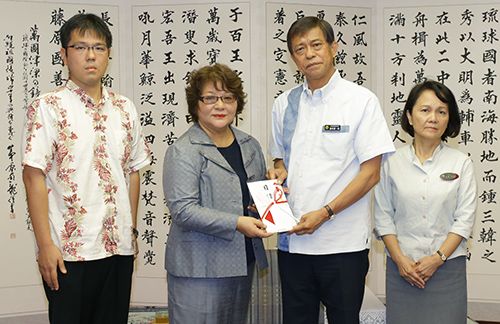
September 6, 2018 Ryukyu Shimpo online edition
The late Takeshi Onaga died on August 8 at the age of 67 while serving as governor of Okinawa.
On September 6 his widow, Mikiko, and their eldest son, Yuichiro, visited the Prefectural Office to make a return gift for all the gifts received from prefectural citizens at Onaga’s funeral.
This return gift was a donation of 2 million yen to the Okinawa Children’s Future Foundation.
Mikiko said: “Onaga was troubled by child poverty in Okinawa being double that of the national average, and he worked desperately to break the cycle of poverty.
No matter how huge and close military base issues come to be, I want use this opportunity to develop preparedness to support children.”
Vice Governor Kiichiro Jahana is also the chair of the Okinawa Children’s Future Foundation. Jahana said: “The governor said that he would take care of all the adults’ responsibilities that he could. He even pursued surveys and accumulated 100 million yen in funds. I will firmly carry through [the governor’s] wishes and make efforts to counter child poverty.”
As he spoke, thinking back on Governor Onaga while he was alive, Vice Governor Jahana’s voice broke and his eyes reddened.
Mikiko, wiping away tears, encouraged Jahana to follow through with his plans on combating child poverty.
Mikiko also donated to the Naha City Child Future Support Project Propulsion Fund and the Henoko Fund, which aims to stop construction of the Futenma replacement facility in Henoko.
In 2016 the Okinawa Children’s Future Foundation appointed Governor Onaga as its top official, establishing itself as an organization of both the government and the people.
Governor Onaga naturally made efforts such as calling on major industries in Okinawa to help out by making donations to the fund.
He was able to concentrate his efforts into resolving a variety of problems that affect children in Okinawa.
(English translation by T&CT and Erin Jones)
Go to Japanese

September 7, 2018 Ryukyu Shimpo
Mikiko Onaga, the wife of Okinawa Governor Takeshi Onaga who died suddenly on August 8 at the age of 67, had an interview of Ryukyu Shimpo at her home in Naha City on September 6. Mrs. Onaga said that right after Governor Onaga underwent surgical removal of his pancreatic cancer in late April, it was found that the cancer had spread to the liver.
Governor Onaga had said, “I might not hold out until December,” while preparing his mind for death. He only told his family members about his cancer spreading, and continued work toward revoking land reclamation approval in Henoko, Nago City.
Mrs. Onaga said, “I think he wanted to see the revocation through, himself.
He should be pleased that the people of the prefectural government including his vice governors have worked hard to carry out his wishes.”
Governor Onaga, who held a press conference to announce revocation of land reclamation approval on July 27, hid the signs of his health decline such as not being able to walk properly.
Governor Onaga said in his hospital room after being re-admitted, “Okinawan people may say that it is not enough, but I did the best I could do.” Mrs. Onaga replied, “No Uchinanchu will tell you that you are not enough.”
Mrs. Onaga said, “[My husband] used to say, ‘There are people laughing behind the backs of the Okinawan people on the right and left who are fighting against each other.
Okinawa needs to come together as one.’ He devoted his life to the Uchinanchu until the end.”
(English translation by T&CT and Megumi Chibana)
Go to Japanese
September 6, 2018 Ryukyu Shimpo
The “Henoko Okinawa Referendum Committee,” (Jinshiro Motoyama, representative), which is demanding a referendum be held in Okinawa to decide whether or not to allow land reclamation at Henoko in Nago City as part of the relocation of MCAS Futenma, submitted their ordinance application directly to vice governor Kiichiro Jahana September 5.
Vice governor Moritake Tomikawa, the current acting governor, has until September 20 to call a session of the Okinawa Prefectural Assembly, where it will be presented as a bill.
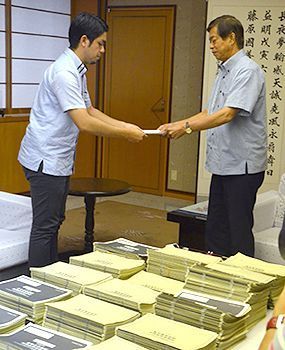
Henoko Okinawa Referendum Committee representative Jinshiro Motoyama (left) presenting vice governor Kiichiro Jahana (right) with the referendum application. September 5, Okinawa Prefectural Office Press Club
Motoyama and the committee visited the prefectural office to submit the proposed referendum as well as the supporting signatures.
Motoyama said, “We expect the smooth cooperation of the assembly, who should seriously consider the will of the Okinawan people, deliberate the bill, and then approve it to be put to a referendum vote quickly.”
Kiichiro Jahana, vice governor who accepted the application, stated, “I think (the late) Governor Onaga would be greatly pleased by the large number of signatures collected in such a short time.”
After being reviewed by local election committees, a total of 92,848 valid signatures were gathered by the referendum committee from 41 towns and cities in Okinawa.
A gross total of 100,950 signatures were gathered, but a number of them were invalidated due to things like ink bleeding rendering some seals unreadable.
When the bill is presented to the assembly, the acting governor will also give a statement outlying their position.
However, it is predicted that regardless of intent, only the wording and phrasing of the bill will be edited.
When the bill is presented before the assembly, a representative from the resident referendum committee will also have a chance to make a statement outlying their position to the assembly.
If the bill is approved as expected, within 6 months of the official announcement it will be put to a vote.
The referendum put forth by the committee will ask residents if they support or oppose land reclamation at Henoko, Nago City for the purposes of new U.S. military base construction.
Whichever response receives the majority of votes as well as a vote total exceeding 25% of all registered voters will be presented to the governor of Okinawa, who will have to act in accordance with the result.
Okinawa Referendum Timeline:
9/5: The Referendum Committee submits the application to the prefectural office -> Within 20 Days -> The acting governor will convene the Okinawa Prefectural Assembly to present the application for bill creation
9/30: Okinawa gubernatorial election
The Okinawa Prefectural Assembly will review and approve the bill and other related items
Spring 2019: Referendum voting to take place
(English translation by T&CT and Sam Grieb)
Go to Japanese
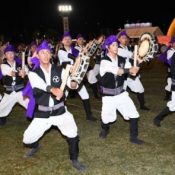
September 3, 2018 Ryukyu Shimpo
September 2 was the final day of the 63rd Okinawa Zento Eisa Festival, which was held at Koza Athletic Park in Okinawa City.
Fourteen groups performed Eisa at the festival.
According to organizers, over the three days of the festival a record number of 34,000 people visited Okinawa City or the “City of Eisa.” On the final day groups from each region of Okinawa successively performed powerful traditional dance and presented creative theater performances.
These Eisa dance performances were skillful; the sounds of sanshin reverberated with the sound of the taiko drums, reminding spectators of summer in Okinawa.
Members of the Yamazato Youth Group of Okinawa City brought the festival to a close, as they did two years ago.
They charmed the audience from the beginning with their intense drumming, lively dancing, and movements in orderly lines.
Up to this point the most attended festival was the 56th Okinawa Zento Eisa Festival in 2011, to which 33,000 people came.
(English translation by T&CT and Erin Jones)
Go to Japanese
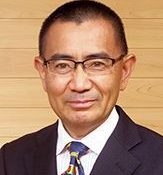
August 28, 2018 Ryukyu Shimpo
On August 27, Okinawa Prefecture announced that the ninth Okinawa Peace Award will be awarded to Japan International Volunteer Center (JVC), an international NGO based in Tokyo and headed by Takaki Imai.
The Okinawa Peace Award is presented to individuals and organizations engaged in activities that contribute to the construction and maintenance of peace in the Asia-Pacific region.
The Award was founded in 2002 and is presented once every two years.
JVC was established in 1980 to provide aid to displaced people in Indochina.
Currently, JVC is active in eleven countries in Asia, Africa, and the Middle East.
Activities include enhancing farming production through training farmers on vegetable and processed goods production.
JVC provides humanitarian assistance such as medical treatment in conflict areas.
In addition, this NGO helped with the relief efforts in disaster-affected areas such as Miyagi Prefecture and Fukushima Prefecture after the Great East Japan Earthquake.
It also makes policy recommendations to international organizations and the Japanese government.
The Okinawa Peace Award selection committee chose JVC from among 23 individuals and organizations.
Part of the reason JVC was selected was stated to be because “JVC has made remarkable achievements in their multilateral, widespread, and regional activities over a long period.”
Award winners receive 10 million yen in prize money and a gift.
The prize money is covered by donations from Okinawan citizens.
The award ceremony will be held at the ANA Crowne Plaza Hotel Okinawa Harborview in Naha City on October 23.
Go to Japanese
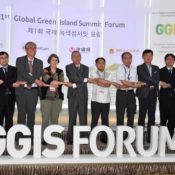
August 28, 2018 Ryukyu Shimpo
Yuri Shimizu reports from Jeju
On August 27 the governors of Okinawa, Jeju Special Self-Governing Province in South Korea, and Hawaii met together on Jeju Island for the first Global Green Island Summit (GGIS) forum to discuss island regional environmental issues.
About 100 people attended, including residents of these three islands and residents of islands in the South China Sea as well.
These islands have many features in common among aspects such as their natural environments, topography, and industries.
Persons concerned with these issues came together to discuss various points of view on the importance of the coexistence of the environment and tourism, and environmental protection.
On the first day personnel and experts from each municipality made presentations on dealing with reports and the environment in cases of abnormal weather such as droughts, hurricanes, and typhoons.
Professor Junichiro Tsutsumi of the University of the Ryukyus reported on policies to accomodate climate change, and Professor Emeritus Tomio Kuroda of the University of the Ryukyus reported on the Fukuzato underground dam project on Miyakojima.
Director Hiroshi Ohama of the prefectural government’s Environment Department explained policies including countermeasures to garbage washing onshore from overseas.
Touching on the issue of garbage from China and South Korea washing ashore in Okinawa, he requested cooperation from abroad with the words, “This is something that can be countered not just from Okinawa.”
Hawaii is striving to implement a low-carbon society, with the goal of switching four islands to renewable energy by 2045.
Chief of Staff Melissa Miyashiro of the Blue Planet Foundation, an environmental protection group from Hawaii, said that they are expecting tourism to increase, and use of aircraft to increase as well. She also mentioned the importance of raising efficiency.
Jeju Island’s officials have declared the intent to reduce the island’s carbon emissions to essentially zero by 2030.
An Asia climate change education center’s representative gave information on using wind and solar power for electricity, and reported on efforts toward the goal of making a 100 percent electric automobile.
This representative stated, “It’s important to gain societal understanding and come to alter viewpoints on ethics.”
The last day of the Summit was August 28, at which time representatives of the three municipalities signed a joint declaration concerning environmental protection that they had compiled.
(English translation by T&CT and Erin Jones)
Go to Japanese
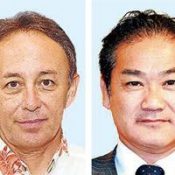
August 30, 2018 Ryukyu Shimpo
The 13th Okinawa gubernatorial election, which will be officially announced September 13, is set to take place one month from the date of this article.
Ginowan Mayor Atsushi Sakima, 54, backed by the Liberal Democratic Party (LDP) and Komeito, and Liberal Party Congressman Denny Tamaki, 58, have both announced their candidacies, and with the possible exception of an independent newcomer also joining the race, the election will come down to a head-to-head matchup between the two well-known politicians.
The campaign leading up to the election will be extremely short following the death of Okinawa’s previous governor, Takeshi Onaga. The election will unsurprisingly take the form of the long-standing battle surrounding the new base construction at Henoko as part of the relocation of MCAS Futenma; the LDP and Komeito, a coalition which controls Japan’s central government and is a major supporter of the base construction is backing Sakima, while the coalition that controls Okinawa’s prefectural government, which recently led a petition opposing base construction, is backing Tamaki.
Sakima has said that regarding the major point of contention that what matters is “whether or not we can return,” the land occupied by MCAS Futenma.
Using the campaign slogan, “From Confrontation to Conversation,” he is centering his campaign policies about negotiating with the central government for economic stimulus and the acquisition of additional budget from the central government for Okinawa.
Tamaki has stressed that, “The battle over the new base construction is something that cannot be ignored.” Campaigning as a successor to the Onaga administration, Tamaki’s campaign slogan is, “Autonomy and co-existence,” and plans to continue with the pan-Asia-focused economic development strategy formulated by Onaga during his administration.
(English translation by T&CT and Sam Grieb)
Go to Japanese
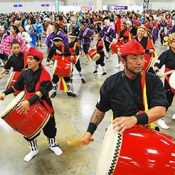
September 3, 2018 Ryukyu Shimpo
By Fumiaki Jahana
Honolulu – A large number of people flocked to the Hawaii Convention Center in Honolulu September 1 for the start of the 36th Annual Okinawan Festival (hosted by the Hawaii United Okinawa Association), where they enjoyed Okinawan music, traditional culture, and food.
The festival ran September 1-2. Timed in conjunction with the completion of the Hawaii Okinawa Plaza, the festival welcomed artists and performers from both in and out of Okinawa.
The convention floor was buzzing with activity as Hawaiians and Uchinanchu from both islands strengthened their cultural relations.
There was a lineup of 17 performances to take the stage including Eisa dancing, Sanshin, Karate demonstrations, Hula dancing accompanied by Okinawan music, and other dances, and was capped off by a Bon Festival dance accompanied by Okinawan folk music.
Approximately 25,000 people came to the festival to enjoy Okinawan culture and food.
Yasushi Nakao, head of the Chatan Youth Association that performed an Eisa dance at the festival for the first time said, “The energy was amazing,” and noted that the unifying power of the festival for his group and the Hawaiian Uchinanchu gave him goosebumps, commenting, “It was exciting for both groups. I was glad that we could all have fun.”
Yoshiko Nakasone, who has taught Ryukyuan Dance in Hawaii for many years, commented happily on the success of the event and the growth of the younger dancers, saying, “Even though this is the 36th festival, it feels like it has gone by in a flash. I am very happy and relieved to see the younger generation becoming skilled in [Ryukyuan] dance.”
(English translation by T&CT and Sam Grieb)
Go to Japanese
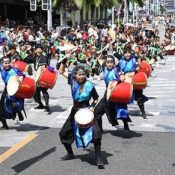
August 6, 2018 Ryukyu Shimpo
The 24th Ten Thousand Person Eisa Dance Parade was held at the Kokusai Street in Naha City in the afternoon on August 5.
With this year’s theme, “traditional versus creative,” 4,000 performers from 62 groups including youth groups from communities and individual groups shared energetic performances to entertain the 78,000-person audience from in and out of Okinawa.
The performers combined traditional eisa and popular eisa dance.
The performance was held throughout ten locations between Saion Square in Asato and Palette-Kumoji.
Many audience-members visited the sites to enjoy the performances by the dancers in traditional costumes in the 30-degree heat.
28-year-old performer Yuki Gushi, who performed a form of creative eisa with the Uehara Daiko team commented, “I felt chimudondon (my heart pounding).
I have been performing eisa since I was in the fourth grade in elementary school, but I noticed as I got older I developed different ways of expression through performance.”
54-year-old visitor Hiroki Matsubara from Toyama Prefecture said, “It was impressive and rhythmical.
It was totally different from the emotional performance we have in Toyama.”
(English translation by T&CT and Sayaka Sakuma)
Go to Japanese
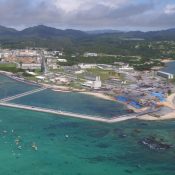
August 31, 2018 Ryukyu Shimpo
Regarding the relocation of the U.S. Marine Corps Futenma Air Station in Ginowan City to Henoko, Nago City, on the afternoon of August 31 the Okinawa prefectural government revoked the land reclamation approval given by Governor Takeshi Onaga’s predecessor, Hirokazu Nakaima.
The central government is proceeding with construction of a new base in Henoko for the Futenma replacement facility following the 2013 land reclamation approval by former governor Nakaima.
Revocation would remove legal basis for land reclamation, and construction would stop.
Although the government initially planned to start depositing soil into the Henoko sea area on August 17, this will soon be impossible.
The government is considering legal countermeasures such as asking the court to suspend the execution to stop the effect of the revocation.
The prefectural government played a decisive card by revoking the land reclamation approval.

At 3:23 p.m. on August 31 Okinawa prefectural government officials enter the Okinawa Defense Bureau office in Kadena Town to deliver a notice about revoking land reclamation approval.
This conflict between the prefectural government and the central government over the new base in Henoko will enter a critical phase as it enters the courts once again.
On August 31 the Okinawa prefectural government’s Michio Tokashiki, deputy director general in charge of military base affairs, and Yoshinari Matsushima, deputy director general in charge of civil engineering development, visited the Okinawa Defense Bureau to deliver a notice about revoking land reclamation approval.
Later, the prefectural government’s deputy governors Moritake Tomikawa and Kiichiro Jahana held a press conference to explain the grounds for the decision in detail.
If the central government takes legal actions and the court permits a suspension of execution of this revocation, the construction will likely be resumed sometime within a few weeks or a few months.
The central government has been delaying soil deposits past the planned initial date of August 17.
The prefectural government carried out revocation prior to the gubernatorial election and before soil depositing by the central government.
This timing is drawing attention to how the central government will respond, what will happen in court, and how it will affect the gubernatorial election.
Governor Takeshi Onaga announced that he had ordered the relevant department directors to pursue revocation procedures at a press conference held on July 27, shortly before his death on August 8.
At the press conference, Governor Onaga stated that he was not willing to accept the government’s attitude to forcibly push through construction of a new base in Henoko, which was decided upon more than 20 years ago.
The prefectural government has been proceeding with revocation procedures, carrying through Governor Onaga’s strong will after his death.
(English translation by T&CT)
Go to Japanese
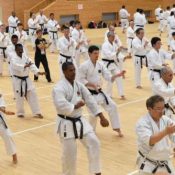
August 28, 2018 Ryukyu Shimpo
By Taichi Hirayasu
“Martial Arts Tourism,” the new tourism initiative in Okinawa that hopes to attract Karate-ka from all over the world for things such as training, has been garnering a lot of attention.
There are reportedly upwards of 130 million Karate practitioners and fans globally, and Okinawa is hoping their call to the homeland of Karate will yield great economic results.
The prefecture has been pouring its energy into attracting Karate-ka with things such as establishing travel companies that specialize in Karate in a flurry of activity that is being referred to as martial arts tourism.
At the 1st Okinawa International Karate Tournament held August 1-7 this year, approximately 1,100 entrants from 40 countries and regions participated.
Between athletes, staff, and fans, the event hosted as many as 26,000 people at the tournament in total.
The tournament welcomed people from not only major western markets such as the United States, Germany, and France, but also countries such as Argentina, China, and South Africa.
A representative from the Okinawa Karate Promotion Office explained, “We saw some cases of parties of as many as 10 or 20 people that included not only the competing athlete, but also friends from their dojo and family. The Okinawa Prefectural government plans to continue promoting policies that continue to draw Karate-ka to Okinawa from abroad.
The Global Market
It has also become clear that Karate-ka who visit Okinawa for training stay longer than a regular tourist visit. In survey conducted by Okinawa in 2016, Karate-ka who come to Okinawa for training stay an average of nine days.
This is much longer than the average stay of someone visiting Okinawa for sightseeing, which averages 3.71 days.
On August 21, when welcoming representatives from Nepalese Karate as part of a goodwill tour, Takao Kadekaru, head of Okinawa’s Department of Culture, Tourism, and Sports expressed his view, saying, “In order to improve the economic benefits from tourism, increasing stay time is essential. By adding Karate-ka to the existing tourism visitors, the economic results can only improve.” He also stressed the potential of martial arts tourism, saying, “There is a global market [for it].”
However, many issues still remain. In the “Okinawa Karate Promotion Vision,” developed by Okinawa Prefecture earlier this year, the level of awareness of Okinawa as the birthplace of Karate is still low, and the economic value of Karate has yet to be firmly established.
Getting the word out about dojos
Tsuneo Kinjo, vice president of the Okinawa Karate and Kobudo Alliance, who has experience teaching overseas feels that, “It is well known abroad that Okinawa has many fantastic Karate instructors.” Previously, there were many foreigners who imagined Tokyo when they thought of Karate, but, “The internet has helped spread awareness for Okinawa as the birthplace of Karate.”
Ageshio Japan (Naha, Okinawa; Kenjiro Ueda, CEO), a travel company that specializes in Karate, has recently began operations, and has started accepting foreign clients looking to train in Okinawa.
People have begun contacting the company about training from all over the world including Europe, the Americas, Africa, and the Middle East, and CEO Kenjiro “Kenny” Ueda feels that, “Martial arts tourism in Okinawa can only grow from here.”
However, Ueda also says, “Not enough is being done to get the word out about the diverse, attractive, and unique Okinawan dojos,” stating his opinion that there is room for improvement in the current martial arts tourism movement.
There are reportedly many cases of foreign Karate-ka inquiring about lessons in the styles of Karate taught at Okinawan dojos.
Ueda indicated, “It is necessary to also make an effort to make it easy for people to see the appeal of Okinawan dojos, and learn more about the techniques taught by the masters who inhabit them.
Since Okinawa is the mecca of Karate, I personally believe that it is possible to increase the number of Karate-ka visiting from the tens of thousands to the millions.”
(English translation by T&CT and Sam Grieb)
Go to Japanese












 Webcam(Kokusai Street)
Webcam(Kokusai Street)


